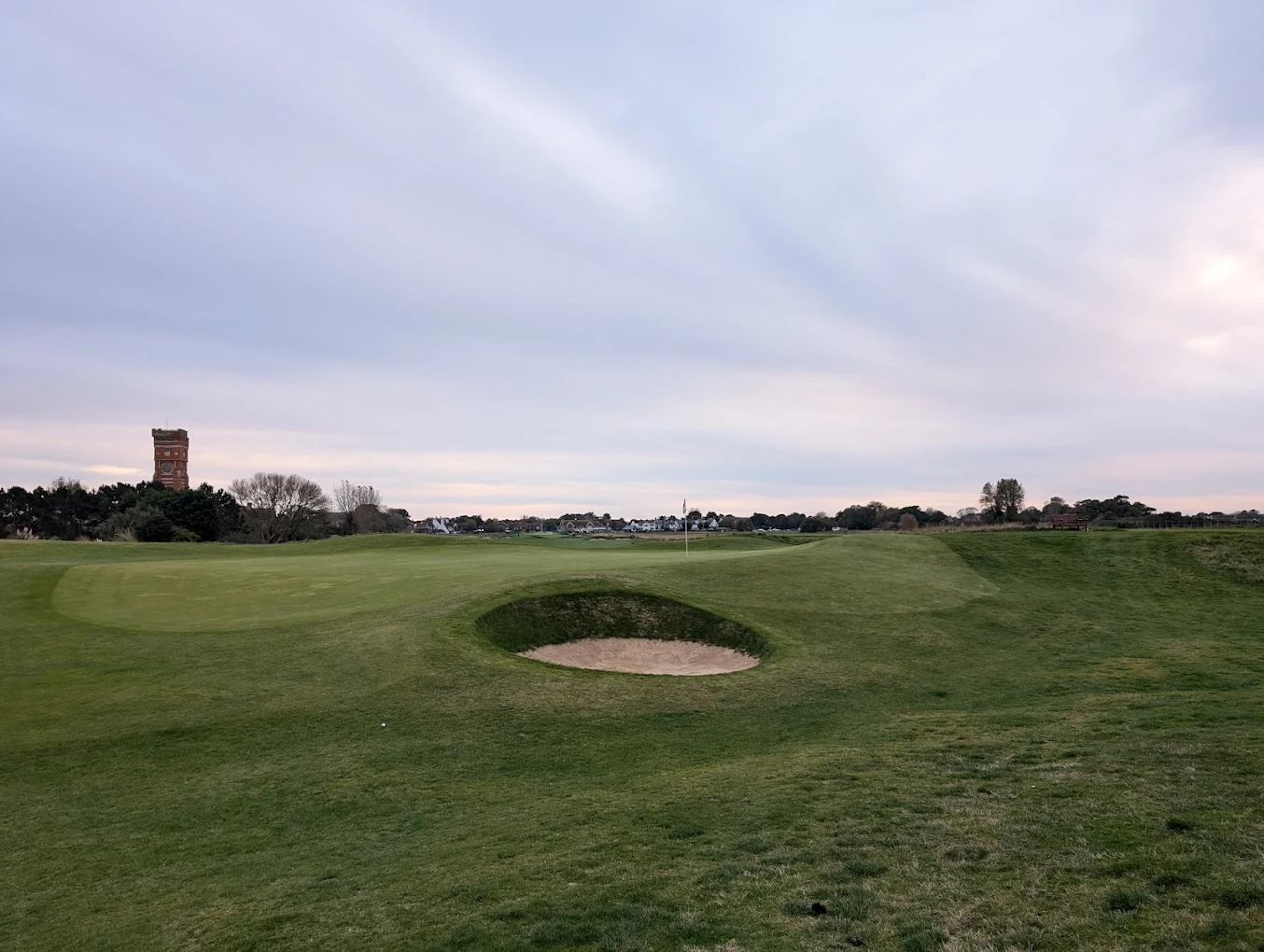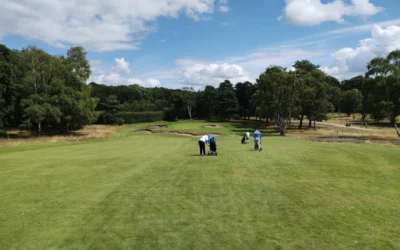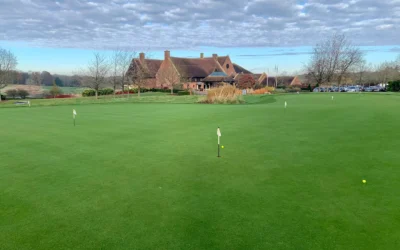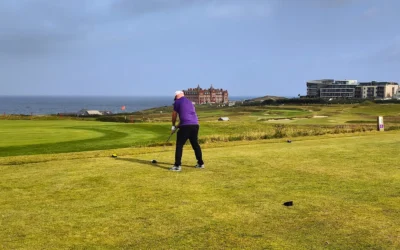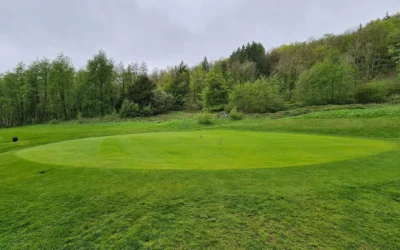Littlestone Golf Club
Littlestone Golf Club (Littlestone, Kent, England)
Nestled on the stunning coastline of Kent, Littlestone Golf Club stands as a testament to the timeless allure of links golf. With its undulating fairways, challenging bunkers, and breathtaking views of the English Channel, this course offers a golfing experience that is both thrilling and serene. As one of England’s top 100 golf courses and a proud host of The Open Qualifying events, Littlestone beckons golfers from around the world to test their skills and immerse themselves in its rich history and natural beauty.
Whether you’re teeing off amidst iconic landscapes or following in the footsteps of golfing legends, Littlestone promises an unforgettable journey through the heart of traditional links golf.
Key Details
- Location: Littlestone, Kent, England
- Length: 6,632 yards
- Par: 71
- Designers: William Laidlaw Purves, David Herd (original), James Braid (tweaked), Alister MacKenzie (revised)
- Established: 1888
- Notable Events: Hosted The Open Qualifying five times, L.G.U. Ladies Championship (1894)
History and Significance
Littlestone Golf Club, established in 1888, was founded by William Laidlaw Purves and David Herd, with Purves bringing his expertise from designing Royal St George’s. The course quickly gained prominence, hosting the first L.G.U. Ladies Championship in 1894, a remarkable feat for a new course. Its early recognition as a premier UK links course attracted notable figures, including Charles Blair Macdonald, who drew inspiration from Littlestone’s 16th hole for his designs in America.
The course evolved through strategic enhancements by renowned architects. In the early 1900s, James Braid added bunkering that remains iconic on holes like the 12th and 16th. Post-World War I, Alister MacKenzie, later celebrated for Augusta National, redesigned key holes, including the 6th, 8th, and 17th, and reshaped the 5th and 18th greens. Post-World War II, Frank Pennink modified bunkers, and in 2000, Donald Steel and Peter Alliss made minor updates to maintain the course’s challenge. New tees added in 1997 on holes 4, 7, 9, 11, and 12 ensured Littlestone remained a test for modern players.
Littlestone’s championship pedigree is underscored by hosting The Open Qualifying five times, with the course record of 64 set by Paul Wesselingh in 2003. Its cultural impact is evident in its rankings—top 100 in England and top 125 in the UK—and praise from golfers like Harry Vardon. The course’s influence extends globally, with Macdonald’s admiration highlighting its architectural significance. Today, Littlestone remains a cherished destination for those seeking a pure links experience.
Course Features
Littlestone Golf Club is a quintessential links course, set on naturally undulating terrain between Romney Marsh and the English Channel. Its 6,632-yard, par-71 layout challenges golfers with firm, fast fairways and greens that reward precision. The course’s rugged dunes and deep bunkers, including the notorious “Anaconda” on the 16th, create a strategic test. Coastal winds add complexity, demanding adaptability on every shot.
The course’s challenges include blind shots, elevation changes, and greens renowned for their quality—described as some of the UK’s finest for their firmness and pace. Strategic bunkering, particularly Braid’s contributions, requires careful course management. Despite its difficulty, Littlestone’s scenic beauty elevates the experience. Views of the English Channel, Romney Marshes, and the Strait of Dover provide a stunning backdrop, making each hole visually spectacular. The course’s microclimate, one of the driest in the UK, ensures year-round playability without temporary greens.
Signature Holes
Littlestone’s layout is filled with memorable holes, but three stand out for their design and challenge:
- Hole 6 (Par 3, 158 yards): This Alister MacKenzie-designed par 3 is deceptively tough. The small, raised green is difficult to hold, guarded by a pot bunker on the right and a steep left bank that complicates recovery. Precision is paramount, as errant shots face a tricky up-and-down.
- Hole 16 (Par 4, 469 yards): Regarded as the course’s toughest, this par 4 demands a long, accurate drive past a right-hand bunker to set up a chance at reaching the green in two. The green, visible toward a water tower, requires a precise approach. Shorter hitters must play left for a clearer third shot. A par here is a triumph, often defining a round.
- Hole 17 (Par 3, 185 yards): Another MacKenzie gem, this par 3 is celebrated for its strategic depth and beauty. The green, surrounded by bunkers and undulations, demands a pinpoint tee shot. Its challenging nature draws comparisons to iconic par 3s, testing both skill and composure.
These holes embody Littlestone’s blend of strategic challenge, historical significance, and scenic allure.
Why Visit
Littlestone Golf Club is a must-visit for golfers seeking a true links challenge steeped in history. Its ranking among England’s top 100 courses and its role in hosting The Open Qualifying five times make it a bucket-list destination. The course tests every facet of a golfer’s game, from long drives to delicate short-game shots, all while navigating coastal winds. As one reviewer noted, “Great test of golf on this superb links course.”
The emotional resonance of playing where legends like Harry Vardon competed, combined with the course’s stunning coastal setting, creates lasting memories. The welcoming atmosphere, praised in reviews like “The clubhouse is very hospitable”, enhances the experience. Practical benefits include a well-equipped pro shop, practice facilities with TrackMan technology, and a restaurant with course views, making Littlestone a complete golfing destination.
Facilities
Littlestone Golf Club offers top-tier amenities to ensure a comfortable visit:
- Clubhouse and Dining: The clubhouse features a restaurant serving local cuisine with panoramic course views, praised for its “lovely atmosphere”. It’s a welcoming space for post-round relaxation.
- Practice Areas and Services: A short game area and performance studio with TrackMan launch monitors cater to skill improvement. The pro shop, opened in 2018, stocks extensive golf equipment and apparel, including Littlestone-branded items. PGA professionals offer lessons, and a SAM PuttLab system aids putting analysis.
Contact Details and Directions
- Address: St. Andrews Road, Littlestone, New Romney, Kent, TN28 8RB
- Phone: +44 (0)1797 363355
- Email: info@littlestonegolfclub.org.uk
- Directions: Located 20 miles south of the M20 off A259, about an hour’s drive from London. By public transport, take the HS1 train from London to Folkestone, then local transport to New Romney, a short distance from the club.
- Public Transport: New Romney station is nearby, with connections via Folkestone.
- Parking: Ample parking in the Warren Car Park, first left upon approach.
- Map: View on Google Maps
Green Fees and Booking
Littlestone welcomes visitors with “member for the day” status, allowing play from championship tees. Green fees for 2025 range from £50-£80 per round, midweek and weekends, offering excellent value for a top-tier links course. Twilight rates after 2pm may be lower, around £50.
|
Season |
Non-Resident (Before 1pm) |
Non-Resident (After 1pm) |
Hotel Guest |
|
Apr–Oct |
£80 |
£50 |
N/A |
|
Nov–Mar |
£50 |
£50 |
N/A |
- Booking Process: Book via phone at +44 (0)1797 363355 or email golf@littlestonegolfclub.org.uk (Littlestone Golf Club).
- Requirements: Proper attire is mandatory; check the dress code on the club’s website. No handicap certificate is required, but visitors should be prepared for a challenging course.
- Membership Options: Available; contact the club for details.
Nearby Attractions
Kent’s Romney Marsh region weaves together coastal splendor and historical richness, positioning Littlestone as an ideal base for exploration. Beyond the fairways, the area brims with attractions, from serene beaches to quaint railways, offering golfers and companions a chance to immerse themselves in the cultural and natural treasures of southeast England.
|
Attraction |
Appeal |
Distance from Littlestone |
|
Littlestone Beach |
Coastal walks, shingle shores |
0.5 miles |
|
Romney, Hythe & Dymchurch Railway |
Historic steam train rides |
2 miles |
|
Dungeness Nature Reserve |
Unique desert-like landscape |
10 miles |
|
Rye Heritage Centre |
Medieval town, history tours |
15 miles |
|
Royal St George’s Golf Club |
World-class links golf |
20 miles |
|
Leeds Castle |
Stunning castle, gardens |
30 miles |
|
White Cliffs of Dover |
Iconic cliffs, scenic trails |
25 miles |
- Littlestone Beach: Just steps from the golf club, this shingle beach offers a peaceful retreat with sweeping views of the English Channel. Ideal for leisurely walks or birdwatching, its promenade invites visitors to soak in the coastal ambiance, with opportunities to spot migratory birds or enjoy the rhythmic crash of waves.
- Romney, Hythe & Dymchurch Railway: This 13.5-mile miniature steam railway, one of the world’s smallest public railways, delivers a nostalgic journey through Kent’s picturesque countryside. Perfect for families, the ride connects historic towns and offers glimpses of Romney Marsh’s unique landscape, blending charm with scenic beauty.
- Dungeness Nature Reserve: A hauntingly beautiful shingle desert, Dungeness features a lighthouse, abandoned fishing boats, and rich wildlife. Known as the UK’s only desert, this reserve captivates with its stark landscape, ideal for photography, birdwatching, or exploring the nearby nuclear power station’s eerie backdrop.
- Rye Heritage Centre: The medieval town of Rye enchants with cobbled streets, half-timbered houses, and historic inns. The Heritage Centre offers guided tours and a model of Rye’s Cinque Ports past, while nearby shops and tearooms provide a cozy retreat for visitors seeking history and charm.
- Royal St George’s Golf Club: A short drive away, this Open Championship venue ranks among the world’s elite links courses. Golfers can extend their trip with a round on its storied fairways, where legends like Greg Norman and Darren Clarke triumphed, adding a prestigious complement to Littlestone’s challenge.
- Leeds Castle: Billed as the “loveliest castle in the world,” this 12th-century fortress sits amid 500 acres of manicured gardens and parkland. Visitors can explore its opulent interiors, enjoy falconry displays, or navigate a maze, making it a captivating day trip for history buffs and families alike.
- White Cliffs of Dover: These iconic chalk cliffs symbolize England’s coastal heritage, offering breathtaking views over the Channel. Walking trails wind through the cliffs, revealing historic wartime tunnels and vibrant wildflowers, providing a scenic and reflective experience just a short drive from Littlestone.
Frequently Asked Questions (FAQs)
How much are green fees at Littlestone?
Green fees range from £50 to £80 per round, with twilight rates around £50 after 2pm.
How do I book a tee time?
Call +44 (0)1797 363355 or email golf@littlestonegolfclub.org.uk to reserve.
Is Littlestone suitable for beginners?
It’s challenging but playable for beginners with strategy; better for intermediate golfers.
When is the best time to play?
Spring and autumn have mild weather; after 1pm for lower rates and quieter play.
What’s the dress code?
Smart golf attire required; no jeans or trainers. See club website for details.
Are caddies available?
Caddies may be available; confirm when booking.
What practice facilities are offered?
Short game area and TrackMan-equipped performance studio for skill improvement.
How do I get to Littlestone?
Drive via M20 and A259 (1 hour from London) or take HS1 train to Folkestone, then taxi.
Are there nearby accommodations?
Local hotels and B&Bs available; contact club for recommendations.
What attractions are nearby?
Littlestone Beach, Dungeness, Rye, Leeds Castle, and White Cliffs of Dover.
What tournaments has Littlestone hosted?
Hosted The Open Qualifying five times and L.G.U. Ladies Championship in 1894.
Who designed Littlestone?
William Laidlaw Purves and David Herd, with updates by James Braid and Alister MacKenzie.
What’s the course record?
Paul Wesselingh shot 64 during The Open Qualifying in 2003.
Can visitors join as members?
Membership open; contact club for details.
Why is Littlestone famous?
Known for its links design, Open Qualifying history, and MacKenzie’s contributions.
Enville Golf Club Lodge Course
Enville Golf Club Lodge Course (Enville, West Midlands, England) Enville (Lodge) Golf Course, nestled in the picturesque West Midlands of England, offers golfers a unique blend of challenging play and natural beauty. Located in the heart of Staffordshire, this course...
London Golf Club International Course
London Golf Club International Course (Ash, Kent, England) Nestled in the picturesque countryside of Kent, just a short drive from London, London Golf Club International Course is a haven for golf enthusiasts. Picture yourself on the first tee, gazing across rolling...
Newquay Golf Club
Newquay Golf Club (Newquay, Cornwall, England) Nestled along the rugged coastline of Newquay, Cornwall, England, Newquay Golf Club is a beacon of links golf’s enduring charm. Established in 1890 and re-designed by the legendary Harry Colt, this 18-hole course...
Stockport Golf Club
Stockport Golf Club (Stockport, Greater Manchester, England) Nestled in the heart of Greater Manchester, Stockport Golf Club is a beacon of golfing heritage and natural splendor. Founded in 1905, this championship-standard course invites golfers to step onto fairways...
Golf At Goodwood
Golf At Goodwood (Chichester, West Sussex, England) Nestled within the sprawling 12,000-acre Goodwood Estate in West Sussex, England, Goodwood Golf Course offers an unparalleled golfing experience that blends history, natural beauty, and championship-level challenge....
